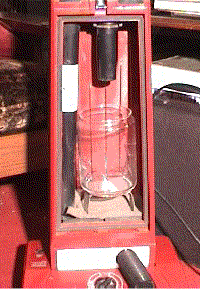|
 This is
an animated picture showing the way that This is
an animated picture showing the way that
the recycling cleaner can actually remove objects from
the carpet even when the front is open and no suction
is present at the cleaning head
Showing work, Wasted by Vacuum Cleaners.
Video of A Practical Experiment to
Demonstrate How The Air Recycling Cleaner Will Collect Dust Without The
Help Of Any Suction.
Setting up the experiment.
The cover is removed from the dust bag
compartment and a bridge to support a glass jar is place into the
cleaner to allow air to go directly into the fan without going through
the cleaning head, this means the cleaner can no longer suck air in from
the floor.
Some rice crispies are placed onto the floor and because it is not
possible to push the cleaner across them when doing this experiment the
cleaner is placed on top of the crispies.
Now, when the cleaner is switched on the air stream that is blowing down
from the exhaust and through the cleaning head takes up the rice
crispies that are underneath the cleaning head.
The air stream then caries the crispies up to the top of the cleaner and
blows them into the glass jar. This all happens very quickly and without
the help of any suction.
A short video clip was taken and had to be slowed down many times in
order for the effect to be seen. The actual speed of the air stream can
be judged by the way the crispies bounce up when they hit the bottom of
the glass jar.
It happened much faster than the camera could capture all the pictures
and the crispies were deposited into the jar in less than one second.
The cleaning operation was done without
any vacuum or suction. When both the suction and the returned air stream
are combined the joint effect produces three times the amount of work
for a given amount of power input, allowing the machine to be run at the
extremely low power of 250 watts. This was confirmed by the tests that
were conducted by, INTERTEK - ETL SEMCO
Research & Testing Centre on behalf of the DTI and the Market
Transformation Pro gramme.
Further work has shown that when the Air Recycling Cleaner system is
combined with a cyclone separator instead of a dust bag the air speed is
greatly increased, further improving the efficiency of the Air Recycling
Cleaner.
There is a very good case for a Dual mode cleaner that can be quickly
switched from a conventional cleaner to an Air Recycling Cleaner this
would overcome the reluctance of manufacturers and the public to abandon
altogether the vacuum cleaner, the system that they are familiar with.
The saving of power is not the only
advantage to be found with the air recycling cleaner, it is quieter, it
does not blow air back into the room to disturb the dust that is on
furniture, curtains, fixtures and fittings ( that is exactly what a
vacuum cleaner does) and could be the reason that
Vacuum cleaners with "high-efficiency
particulate-air filters or HEPA filters are no better than basic vacuum
cleaners at reducing an individual's exposure to dust mites.”
The Captive Air-Flow Cleaner or air recycling cleaner is safe to use in
the presence of people with Asthma and other respiratory disease. It is
safer to use in the presence of young children and elderly people.
Scented sachets are not required and the room will not smell of stale
air, it can use a much smaller motor and that makes it lighter and
easier to use. Manufacturing cost should not be any higher than that of
a Vacuum Cleaner so what more will it take to get someone to manufacture
it.
B. Edginton. © 2005
|